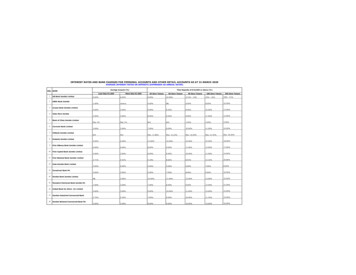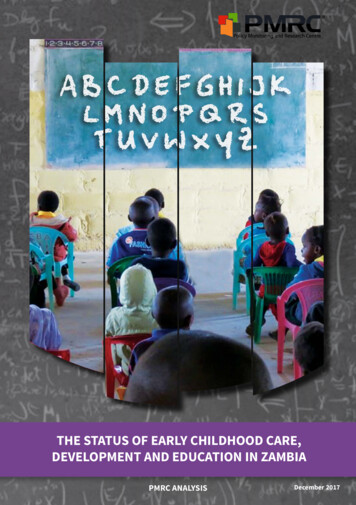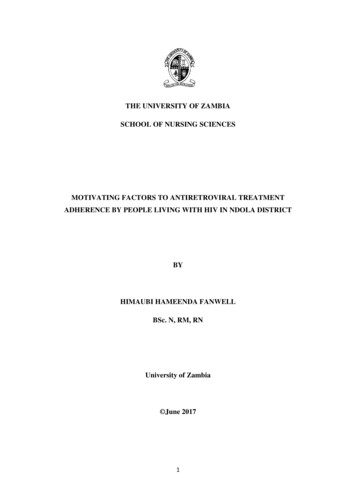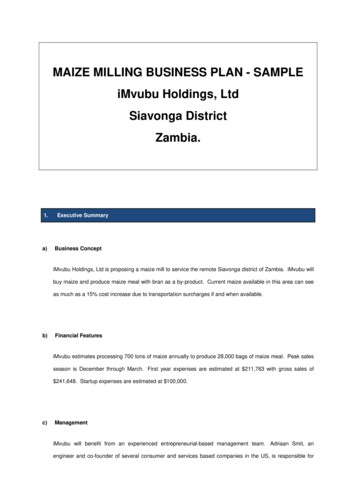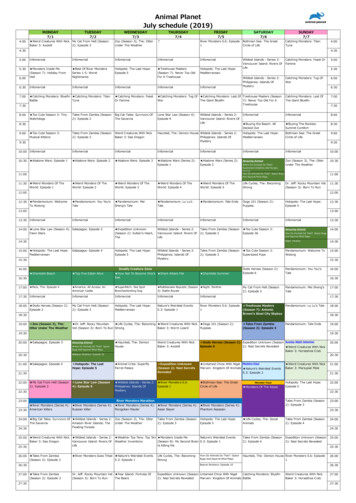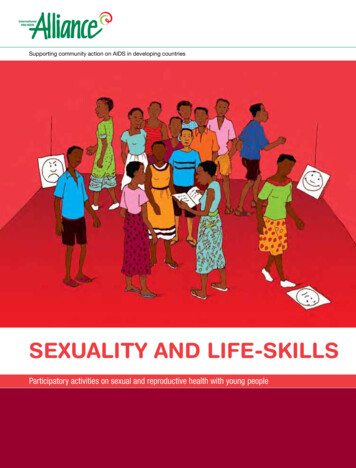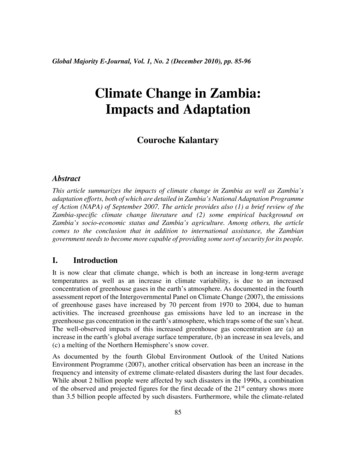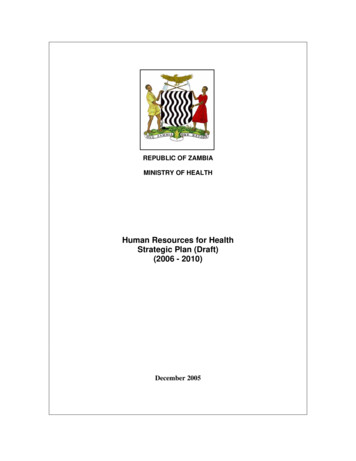
Transcription
REPUBLIC OF ZAMBIAMINISTRY OF HEALTHHuman Resources for HealthStrategic Plan (Draft)(2006 - 2010)December 2005
DRAFTTable of contentsForewordiAcknowledgementiiiExecutive SummaryivMission and Aimxiii1 Introduction12. Human Resources in the Zambian Health Sector63. Current Initiatives to Resolve the Human Resource Crisis224.Guiding Principles for the HRH Strategic Plan235. Objectives and Strategies246. Options for consideration in the implementation of the HR plan377. Key Assumptions With The Strategies418. Risks439. Resourcing the plan4510. Implementation of the strategy4511. Monitoring and evaluation46Annexes49
DRAFTList of tablesTable 1: Current numbers of staff by cadre in the public sector and staff topopulation ratios6Table 2: Staff distribution by province10Table 3: Current Staff Levels versus Recommended Establishment12Table 4: Composite Monthly Pay before tax of a sample of health workers13Table 5: Summary costs of workforce projections and costs 2005 – 201139Table 6: Areas for further investigation40Table 7: Key assumptions associated with the strategies42Table 8: Indicators for monitoring and evaluation of the strategy46Table 9: Annual review and revision cycle for the HR strategy 2006-2010 andresponsibilities48
DRAFTList of STSIDASWApUNFPAUSAIDUTHWHOZHWRSAnnual performance appraisal systemBillion KwachaCentral Board of HealthCasual daily employeeCooperating PartnersContinuing professional developmentGross Domestic ProductHuman resourceHuman resource(s)Human Resources for HealthHuman resource management and developmentHealth Services and Systems ProgramHealth Training Coordinating CommitteeIn-service trainingMonitoring and EvaluationMinistry of EducationMinistry of HealthMinistry of Science, Technology and Vocational TrainingMedium Term Expenditure FrameworkNon-government organisationPersonal EmolumentsPrimary health carePayroll Management and Establishment ControlPerformance management packagePoverty Reduction Strategy PaperPublic Sector Reform ProgrammePre-service trainingSwedish International Development AgencySector Wide approachUnited Nations Population FundUnited States Aid for International DevelopmentUniversity Teaching Hospital (Lusaka)World Health OrganizationZambian Health Workers Retention Scheme
DRAFTForewordSince 1991 Zambia has been pursuing health reforms aimed at providingZambians with equity of access to cost-effective, quality health care as close tothe family as possible. Although there have been some progress towards theachievement of global and national health outcomes, the reforms have not hadthe intended impact of improving the overall performance of the health sector.One of the major obstacles for Zambia to improve its service delivery and theachievement of the Millennium Development Goals related to child and maternalhealth and combating priority diseases including HIV/AIDS and malaria is theshortage of human resources for health.The health sector is facing a major human resource crisis and there areshortages of health workers at every service delivery level. The health sectorrecognises that human resources are critical in the provision of quality healthcare and that to address the current crisis it is essential that it ensures anadequate and equitable distribution of appropriately skilled and motivatedhealth workers providing quality services.Human resource shortages are caused by a number of factors. These include: Inadequate conditions of service (pay, allowances and incentives) Poor working conditions (facilities, supplies and equipment Weak human resource management systems Inadequate education and training systemsIn order to resolve the crisis and address the key issues the Ministry of Healthhas developed a Human Resources for Health Strategic Plan, in consultationwith key stakeholders. The strategies and activities outlined in the Plan attemptto address the concerns of all the stakeholders consulted and to provide aframework to guide and direct interventions, investments and decision making inthe planning, management and development of human resources for health.The Human Resources for Health Strategic Plan demonstrates the scale of thecrisis and highlights some of the key factors that have led to the current situation.It further illustrates the current and ongoing national and district initiatives aimedat reducing the severity of the situation. It outlines the broad objectives,strategies and activities required to address the crisis. The focus of this HRHStrategic Plan is on developing the most appropriate, feasible and cost effectivemix of strategies for both achieving improved staffing levels and making jobs inthe health sector more attractive by improving conditions of service. TheStrategic Plan will be used by the Ministry of Health and its partners in the healthsector to mobilise resources and support in order to strengthen human resourcesfor health.i
DRAFTThe successful implementation of this plan will pose many challenges, but I amconfident that with the concerted efforts and sustained support from government,unions, professional associations, cooperating partners and health workers thatthe urgent HRH needs, the needs of the overall sector and the health needs ofthe population can be addressed.Hon. Sylvia Masebo, MPMINISTER OF HEALTHii
DRAFTAcknowledgementI would like to acknowledge with gratitude the time, expertise and support givenby the Cooperating Partners, Health Professional Associations and the WorkersUnions that contributed to the development of the Human Resources for HealthPlan through their submissions and open discussions.In addition, the Ministry of Health wishes to thank all Cooperating Partners fortheir technical support in the development of this Plan.Dr. S. K. MitiPermanent SecretaryMINISTRY OF HEALTHiii
DRAFTExecutive SummaryIntroductionHuman resources constraints are a key factor in the lack of improvement in theoverall health status of the people of Zambia.In August 2005, His Excellency, the President of the Government of the Republicof Zambia directed the Ministry of Health to develop a plan that would addressthe problems affecting the health sector.In the process of developing the plan, the Ministry of Health consulted its stakeholderswho included the cooperating partners, namely, UNFPA, Embassy of Sweden (SIDA),USAID, Department for International Development (DFID), European Union (EU), HealthServices and Systems Program (HSSP), World Health Organisation (WHO), the RoyalNetherlands Embassy; Trade Unions and Associations representing the variouscategories of health workers, namely: Civil Servants and Allied Workers Union of Zambia(CSAWUZ), Zambia National Union of Health and Allied Workers (ZNUHAW), HealthWorkers Union of Zambia (HWUZ), Medical Council of Zambia, General NursingCouncil, Medical Doctors Association, Resident Doctors Association (RDA) and ZambiaMedical Association.The Ministry of Health and the stakeholders identified as the biggest problem inthe health sector the human resources crisis. The result of His Excellency’sdirective and the contributions from the stakeholders is the Human Resources forHealth Strategic Plan for Zambia (HRH Strategic plan).The HRH Strategic Plan sets out strategies and options for 2006 to 2010 totackle the human resources crisis in the health sector, within the timeframes ofthe National Development Plan and the National Health Strategic Plan 2006 –2010. Its overall aim is:To ensure an adequate and equitable distribution of appropriatelymotivated, skilled and equitably distributed health workers providingquality services.It includes both immediate actions and longer-term processes for achieving fourkey objectives:A.A coordinated approach to planning across the sector Ensure human resource planning is coordinated across the healthsector and is based on the best available data.Develop monitoring and evaluation systems to track progress of theHR Strategic Plan implementation to inform its future development.iv
DRAFTB.An increased number of trained and equitably distributed staff C.Improved productivity and performance of health workers D.Increase training output through the expansion of available trainingplacesIncrease the number of applicants for training by wideningparticipationStrengthen the in service training systemIncrease the numbers of skilled health workers in postImprove the deployment and retention of health workers.Improve the quality of pre service trainingImprove the quality and cost effectiveness of in service trainingImprove performance management capacity and toolsImprove occupational health and work place policies.Strengthened human resource planning,development of systems at all levels.managementand managementandStrengthen human resource planning,development capacity at all levels.The HRH Strategic Plan examines the scale of the problem and the effect it ishaving on the delivery of health services in Zambia. It describes the fundamentalcauses of the problem, suggested solutions, potential impediments to thesolutions, and how to overcome the potential impediments. Importantly, the HRHStrategic Plan presents some quick wins for the 12 months that will result inimmediate impact on the human resources situation.Scale And Fundamental Causes Of The Human Resources ProblemScale Of The ProblemThe key issues that have been identified as affecting the health sector includethe following:(i) the public health sector is currently operating at half the expected number ofhealth workers(ii) high levels of brain drain internally, within the region and to developingcountries.(iii) increased attrition of health workers through deaths and resignations(iv) imbalances in the distribution of health workers between urban and ruralareasAll available evidence clearly demonstrates that the shortage of humanv
DRAFTresources and the increasing attrition of staff are major obstacles to improvedhealth service delivery and the achievement of the health-related MillenniumDevelopment Goals in Zambia.There are currently only just over 600 doctors working in the public sector andthere are severe shortages of nurses and other key staff. Planned interventionsare not being implemented because there is not enough staff or suitably trainedstaff in the health facilities to provide services. The World Health Organisationstates that the current staff establishment would have to increase from 23,176 to49,360 to achieve recommended staff population ratios.The crisis is particularly acute in rural areas where more than 50% of rural healthcentres have only one qualified staff member and numerous facilities are withoutany professional staff at all. The poorest provinces such as the Northern, NorthWestern, Central and Eastern have the most severe staffing shortages.However, many Level 3 hospitals are also seriously understaffed and dozens ofpatients are being attended to by one nurse. New facilities remain unopenedbecause of the lack of available suitable staff.Recent estimates show that across the public sector there is one quarter of thetotal number of doctors required; just over one third of the total number of nursesrequired; and just over one quarter of the total number of Clinical Officersrequired.Attrition rates are also startling. Recent indications show that doctors have thehighest attrition rate (9.8%), followed by nurses (5.3%) and pharmacists (4.25%).Zambia is losing its potential health professionals even before the have qualified:estimates in 2004 showed attrition from doctor and nurse training programmeswas 30%. A substantial number of Zambian health workers are migrating toother countries for greener pastures. In the UK alone, a total of 461 Zambiannurses were recruited between 1998 and 2003.The problem with staffing shortages goes beyond numbers and the overallheadcount. There are severe staffing imbalances in terms of numbers, skills, theskills mix and geographical distribution. These are the result of staffingshortages and absences, high population/staff ratios, unattractive pay andworkplace conditions, poor training quality, weak recruitment procedures,urban/rural disparity, and socio-economic considerations. In addition, Staffingshortages have resulted in increased workloads, low motivation, poorperformance and productivity levels and the deterioration in the quality ofservices and the overall performance of the health sector.Fundamental Causes of the Human Resources ProblemThere is a diverse range of factors that are influencing the current humanresources situation in the Zambian health sector. It is important to bear in mindvi
DRAFTthat these causes cannot be taken in isolation.At a demand and supply level; increased health needs, utilisation of healthservices and new technologies are having an impact on the requirements forhuman resources for health; whilst factors such as education and training, labourparticipation, efficiency and the migration of the health workforce is influencingthe provision of adequate numbers of health workers.In particular, human resource shortages are caused by a number of identifiable factorsincluding: Inadequate conditions of service such as low pay, uneconomicalhousing allowance, lack of medical scheme for health workers,unrevised and discriminatory allowances, limited access to loanfacilities and lack of provision of uniforms for nurses for exampleMedical Doctors currently receive approximately a net pay of 908 permonth compared to an average 2500 within the region. MedicalDoctors requested for minimum composite net pay of K16, 000,000 00consisting of the following basic Salary K13,750,000.00, Housingallowance K4,000,000.00, On Call Allowance K4,125, 000.00,Recruitment and retention allowance 20% of Basic salary,Communication Allowance K500,000.00 Transport AllowanceK1,300,000.00. Poor working environment, that is, inadequate medical and surgicalsupplies and dilapidated work facilities.Weak human resources management systems resulting in delays inprocessing appointment, promotion, confirmation, transfer, paymentsof salaries and other conditions of service to health workersInadequate education and training systems.absence of approved structures for health workers and support staffinadequate funding for the health sector. As a result of the poor working conditions, inadequate conditions of service,absence of approved structures and inadequate funding to the health sector,health workers are attracted elsewhere by better conditions of service and careerdevelopment opportunities. Although current doctors and nurses salariescompare well with other Zambian public sector workers, pay in the private andNGO sectors pay is between 23% and 46% higher whilst some countries in theregion are offering three to four times higher. It, therefore, makes it very difficultto retain these essential cadres.Staff attrition contributes significantly to staffing shortages and increasedworkloads. At larger institutions, the workload of remaining staff has increasedas result of migration. At a health centre where an individual is the last remaininghealth professional, the loss of only health workers has caused more dramaticeffects.vii
DRAFTInadequacy in the education and training systems is also affecting shortages andthe skills and skills mix of staff. This is due to poor training quality, inadequatetraining facilities, shortage of trainers, staff absences and the mismatch betweenskills and health sector needs. Much of the training for doctors and nurses inZambia is focused on clinically oriented training, which produces cadres lackingessential skills and knowledge of public health. In addition, emphasis on theprovision of high-level skills training results in longer training times, which delaysthe production of these scarce cadres.Staffing shortages and increased workloads have also been caused byunauthorised and authorised staff absences and the weak management of theinputs of existing staff.Suggested Solutions To The ProblemThe Ministry of Health and its stakeholders consulted during the development ofthe plan identified the following key areas to be addressed: Making jobs more attractive through improving conditions of service andworkplace environmentUsing staff more effectively and efficiently through improved HRmanagement and practices.Under these main areas of focus, the stakeholders view was that the followingareas require interventions to be incorporated within the HRH Strategic Plan:Conditions of Service Improved and timely payment of salaries benchmarked against the PrivateSector and other countries in the region Improved and timely payment of allowances for accommodation, transportand other expenses Expanded and greater access to the health worker retention schemes. Establishment of a discretionary Staff Enhancement Fund for criticalhealth workers in underserved areas. Accelerated development and implementation of a health workplacepolicy. Provision of staff empowerment schemes such as home ownership, landownership, and car ownership for health workers. Introduction of performance based rewards for health workers. Improved human resources management practicesEnabling And Conducive Workplace Environments Reduced stress caused by heavy workloads, long hours and highstaff/patient ratiosviii
DRAFT Improved supply of equipment, medical supplies and operational transportImproved information and communication facilities, especially in ruralareasImproved housing, especially in rural areas.Improved infrastructure in the health facilities.HR Management, Deployment Systems And Practices, And TrainingOutputs. Development and implementation of health workplace and staff welfarepolicies Approval of proposed Ministry of Health establishment to provide forrecruitment and improved career progression for health cadres. Reduced imbalances in the distribution of existing staff Increased numbers of skilled, motivated and equitably distributed healthworkers providing quality services at all levels. Improved in-service training opportunities for all cadres. Increased pre-service training in-puts and outputsBilateral Agreements Signing of Memorandum of Understanding (MoU) with recipient countriesof migrant health workers from Zambia in order to mitigate the impact ofbrain drain.Potential Impediments To The SolutionsThe health sector is labour intensive and thus cannot achieve it goals without therequired well-motivated human resources. Therefore, the following potentialimpediments to the solutions have been identified due to resources constraints: Selective application of incentives both geographically and among the variouscategories of health workers may lead to de-motivation of cadres that may notbenefit in the initial stages.Reduced budget allocation of resources to the health sector will pose a majorchallenge to the implementation of solutions leading to failure to attain theMillennium Development Goals (MDGs).Delayed approval of the new Ministry of Health Structures may result indifficulties in recruiting and introducing on the payroll of health critical staff.Uncoordinated implementation of retention initiatives through support from wellmeaning cooperating partners at district level may lead fragmentation of effortsand further destabilise health worker situation.Government failure to improve conditions of service for health workers.Continued low outputs of graduated from the pre-service Training InstitutionsHow To Overcome The Potential ImpedimentsTo overcome the potential impediments there is need for Government throughix
DRAFTthe Ministry of Health and its stakeholders to do the following: Develop guidelines for the Discretionary Staff Enhancement Fund (HRH Basket)for the implementation levels that is the district and the hospital levels.Develop activity-based work-plans annually to implement the strategies in theHRH plan according to priorities.Put in place and implement effective monitoring and evaluation mechanismImprove Government budget allocation to the health sectorOperationalise the principal of selective enhancement of salaries and otherconditions of service for key professional and technical staff in the health sectorto be implemented through the Discretionary Staff Enhancement Fund as part ofthe Public Service Reform Programme (PSRP) under the Public ServiceManagement (PSM) component.Ensure that Government urgently approves the new ministry of healthestablishment and recruit qualified and skilled human resources for placement inthe critical areas.Encourage Private Sector participation in pre-service training of health cadres.Encourage pre-service partnerships in running some of the closed Governmenthealth Training Institutions.Quick Wins In The First 12 Months Of Implementing The HRH PlanThe Ministry of Health of Health and its stakeholders identified several quick winsfor implementation in the first 12 months of the HRH Strategic Plan and whichwere felt to be key in beginning the process of tackling the HR crisis in the healthsector. The quick wins identified include the following:Obtain Approval For The New Staff EstablishmentThis will provide the Ministry with approved and funded posts for all healthworkers and thus facilitate timely recruitment and placement of health workers onthe GRZ payroll.Recruitment Recruit all graduating students from health training institutions.Recruitment of retiring Health Workers on contracts in order to fill the gap.Enter into bilateral agreements to recruit foreign health worker.Retention Improve Health Workers remuneration and conditions of service. The Ministry of Health through support from the Royal Netherlands embassy isimplementing a Health workers retention scheme for the rural areas for MedicalDoctors. The retention scheme could be extended to other health workersserving in the rural areas. GRZ is currently paying 20% to HRH who are degree holders in the PublicService as recruitment and retention allowance, this could be extended to otherHRH with critical skills, but are diploma and certificate holders.x
DRAFT Discretionary Staff Enhancement Fund (HRH Basket) which could befunded by both GRZ and Cooperating Partners for provision of thefollowing: Incentive scheme for specialized skills. Special hardship allowance to health workers in rural areas. Home and land ownership schemes Car loans. Support children’s education for staff in rural/remote areas Appropriate transport to all health facilities, especially in therural areas Improve access to ICT facilities Renovate staff housing and facilities in rural districts. Revise upwards the following: Doctors’ on-call allowance. Nurses and clinical officers’ commuted night duty allowanceuniform and upkeep allowance.Payment of all GRZ allowances including housing allowance through thepayroll in order to ensure timeliness.Free Health Services to all Health Workers.Major Accomplishments Envisaged In The Year 2006It is expected that implementation of the above strategies will make the PublicHealth sector more competitive and attractive to health workers both locally andabroad. This will eventually result in significant improvements in service deliveryand improvement in the health indicators.Implementation FrameworkLeadershipThe Ministry of Health HQ will provide strategic guidance to translate thestrategies of the 5-year plan into annual plans. At the national level, a proposedhigh level HR Steering Committee will oversee the monitoring of theimplementation of the Plan.Districts and training institutions will be expected to develop their own humanresource action plans based on their human resource needs. These will beguided by the strategic objectives of this HRH Strategic Plan.ResourcesSubstantial resources will be required to implement the strategies and achievethe overall objectives of the HRH Strategic Plan. Balancing the need to makejobs more attractive and the need to operate within fiscal ceilings will bechallenging. To Improve salaries and other conditions of service for healthxi
DRAFTworkers whilst simultaneously increasing numbers will require the sustainedcommitment and support of the Government, Cooperating Partners, unions,professional associations, health workers and other stakeholders.The estimated amount required to commence the implementation of the HRHPlan in 2006 is about K641 billion as shown in Annex 8 which provides the costimplications for the first three-year MTEF cycle. The Ministry of Health in its 2006budget has included human resources activities to begin the implementation ofthe HRH Strategic plan (2006-2011) to at an estimated budget of K 82.6 billionas can be seen at Annex 9.Monitoring And EvaluationEffective monitoring and evaluation of the activities and outcomes of the Plan willhelp to build that evidence base to ensure that the strategy is achieving its goals.Monitoring the implementation of the HRH Strategic Plan will be done at thenational, provincial and district levels. Monitoring and Evaluation Plans will bedeveloped in line with the HRH Strategic Plan and the Annual Implementationplans, in collaboration with the M&E Unit of the MoH. High-level indicators havebeen developed for monitoring the implementation of the strategy and moredetailed monitoring routines will be developed in Year 1 for use on a monthly,quarterly, biannual and annual basis.xii
DRAFTMission and AimThe overall mission of the health sector is:To provide cost effective quality health services as close to the family aspossible in order to ensure equity of access in health service delivery andcontribute to the human and socio-economic development of the nation.The overall aim of the HRH Strategic Plan is:To ensure an adequate and equitable distribution of appropriately skilledand motivated health workers providing quality servicesxiii
DRAFT1 IntroductionSince 1991 Zambia has been pursuing health reforms aimed at providingZambians with equity of access to cost-effective, quality health care as close tothe family as possible. The health reform process has involved sustained andpurposeful change to improve the efficiency, equity and effectiveness of thehealth sector. However, the reforms have not had the intended impact ofimproving the overall performance of the health sector. The recent status reporton the Millennium Development Goals indicates that while there has been someprogress made, particularly in under-five mortality and HIV/AIDS, maternalmortality rates and the incidence of malaria, TB and other diseases are stillrelatively high, especially in rural areas1. The report indicates that humanresources constraints (e.g. the unavailability of trained staff, lack of supplies) area key factor for the lack of improvement in overall health status.It is evident that the shortage of human resources and the increasing attrition ofstaff are major obstacles to improved service delivery in Zambia. There are onlyjust over 600 doctors working in the public sector and there are severe shortagesof nurses and other key staff. Planned interventions are not being implementedsimply because there is not enough staff or suitably trained staff in the healthfacilities to provide the services2.This situation is not unique to Zambia, rather it is a global phenomenon. Actorssuch as the World Health Organization, the World Bank and global initiativessuch as the Global Fund for HIV/AIDS, Tuberculosis and Malaria (GFATM), haveprioritised support and funding to human resources for health in an attempt toredress the situation3.In August 2005, His Excellency, the President of the Government of the Republicof Zambia, concerned about the shortage of health workers, directed the Ministryof Health (MoH) to develop a plan that would address this situation. The HRHStrategic Plan covers the next five years - 2006 - 2010 in line with the timeframesof the National Development Plan and National Health Strategic Plan 2006-2010.It provides a framework to guide and direct interventions, investments anddecision making for strengthening human resource management anddevelopment (HRM/D) in the health sector. It demonstrates the scale of the crisisand highlights some of the key factors that have led to the current situation. Itfurther illustrates the current and ongoing national and district initiatives aimed atreducing the severity of the situation. The document provides a set of costedoptions for evaluation that would address the major issue of staff shortages.Based on a set of guiding principles, the HRH Strategic Plan sets out the broadobjectives, strategies and activities for the next six years. This provides a1'Zambia MDG Status Report for 2005Ministry of Health (2004). A synopsis of the current staffing crisis and outline proposals foraction.3Ministry of Health (2004). Human Resource Crisis In Zambia. A Paper For The High LevelForum Abuja, December 2004. and HLF Oslo paper, 200521
DRAFTframework for the development of annual implementation plans, and a costedplan for the first year is included as an Annex.Further analysis and investigation of the situation will be required as the Plan isimplemented and reviewed. The implementation of the Plan will be regularlymonitored and evaluated in order to modify and adjust strategies and activities tomore effectively address the situation.In the process of developing the HRH Strategic Plan all the key stakeholderswere consulted to elicit their views on what are the key issues and what would bethe most appropriate strategies and activities for addressing the current crisis.Those consulted included MoH officials, unions representing private and publicsector health workers, professional associations, regulatory bodies, civil societyand Cooperating Partners. Submissions and feedback received from theseconsultations have been incorporated into the Plan and strategies developed toa
D. Strengthened human resource planning, management and development of systems at all levels. Strengthen human resource planning, management and development capacity at all levels. The HRH Strategic Plan examines the scale of the problem and the effect it is having on the delivery of health services in Zambia. It describes the fundamental

